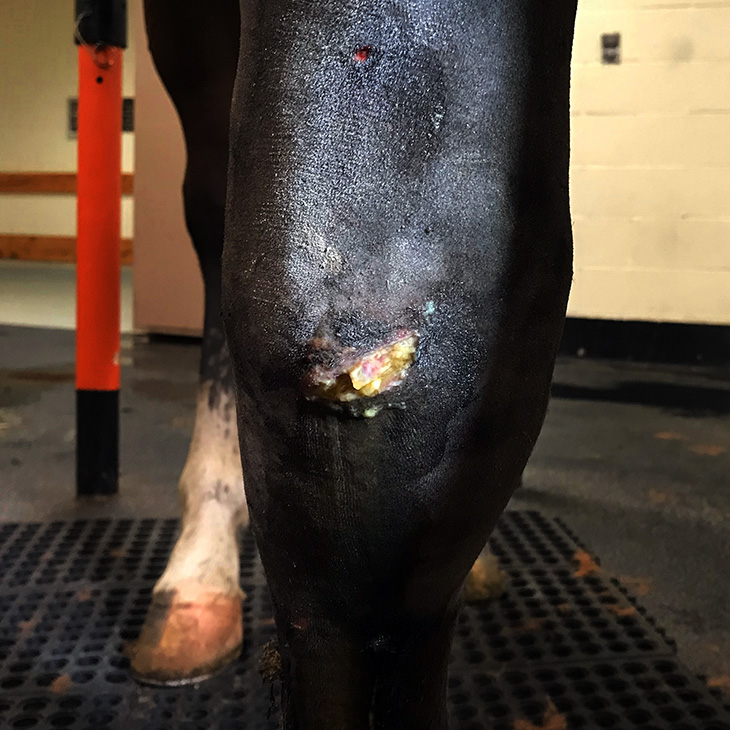
Managing Equine Wounds
Monday, April 20, 2020
Horses are remarkably adept at injuring themselves, even in the safest environments possible. A bit of knowledge and preparation can help horse owners handle these seemingly inevitable wounds. Always consider the wound’s location and severity, degree of lameness caused and initial first aid steps with any injury.
Most commonly, a horse sustains cuts, scrapes and/or abrasions on its legs. Unfortunately, this part of the body has the least amount of soft tissue protection between the skin and such important structures as joints, tendons and ligaments. If a cut involves one of these structures, a small problem can become larger or even life-threatening such as a wound that extends into the joint and infects the joint or a cut that severely damages or completely transects a flexor tendon.
Common sites of injury where joints and/or soft tissue structures are frequently involved include, but are not limited to, the front of the carpus in the forelimbs (often termed the knee), the back of the pastern region in forelimbs or hind limbs, the heel bulbs, and the front of the hock in the hind limbs. For wounds that are large and/or deep, the decision to call the veterinarian is usually relatively easy. Smaller wounds can be trickier to judge, as the depth of penetration may be more difficult to assess. If there is any question as to the depth of the wound and/or potential involvement of a joint, tendon or ligament, get your veterinarian’s opinion before attempting to treat the wound at home.
Wounds are accompanied with variable degrees of lameness. Surprisingly, a horse with a fresh wound to a joint usually doesn’t show lameness unless other tissue damage has occurred. Over time, however, if a contaminated joint becomes infected, the horse will develop severe or even non-weight bearing lameness. Damage to bony structures and tendons or ligaments, as well as severe soft tissue trauma and inflammation with fresh wounds can lead to severe lameness. In these instances, it is important to rule out more severe injuries such as fractures.
Being prepared to provide basic wound first aid is crucial for horse owners. When initially discovered, often a wound will be very dirty or contaminated. One of the best approaches to cleaning a wound on the farm is saline or simple tap water and dilute betadine solution (we recommend a solution of betadine solution and water/saline that is the color of weak iced tea). Diluted chlorhexidine solution can also be used to gently clean wounds. Once cleaned, topical medications can be applied as needed. One of the simplest, safest and most readily accessible options for treating topical wounds is simple triple antibiotic ointment. For wounds where bandaging is not possible, a good alternative is a spray-on liquid bandage substance such as AluSpray.
Bandaging a wound can help keep it clean and protect it from additional trauma during transportation to your veterinarian or while waiting for your veterinarian to come to the farm. The following is a list of general items to keep on hand for a first aid kit and basic wound bandaging:
- Betadine solution
- Triple antibiotic ointment
- Gauze sponges
- Non-adherent dressing pads such as Telfa pads
- Roll gauze (white)
- Cotton roll/combine roll or Gamgee roll
- Brown gauze rolls
- Vetrap or Co-Flex
- Elastikon tape
Remember your veterinarian is a great resource if you have questions about caring for your horse's wounds.
STORY BY: Megan Williams, DVM, DACVS-LA, an assistant professor of equine surgery in the Department of Veterinary Clinical Sciences at OSU’s Veterinary Medical Hospital.
